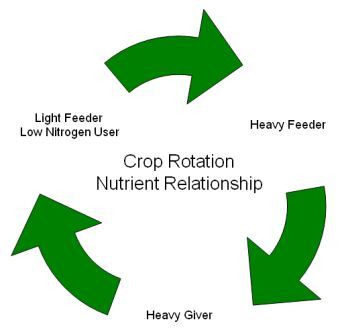 Many diseases and soilborne insects that attack plants remain in the soil even after you harvest the crop. They wait there to reinfest susceptible plants. If you plant the same crop or a closely related one in that site a disease or insect will probably attack the new planting. Prevent this needless loss by rotating your crops each year. The practice costs nothing and could save a lot.
Many diseases and soilborne insects that attack plants remain in the soil even after you harvest the crop. They wait there to reinfest susceptible plants. If you plant the same crop or a closely related one in that site a disease or insect will probably attack the new planting. Prevent this needless loss by rotating your crops each year. The practice costs nothing and could save a lot. Crop rotation requires only a little planning. If you plant tomatoes in one bed this year, then don't plant tomatoes or a related crop in the same bed for the next two years. If possible, it is best to let at least three years pass before planting where the same or related crop grew before.

 It is the nature of disease organisms and pests to take the easiest route. What could be easier than moving down a row of your favorite host plants and attacking one after the other of them? Organic gardeners have known for generations a way to confound many pests, especially those that prefer one particular crop over others, and it doesn't cost a cent.
It is the nature of disease organisms and pests to take the easiest route. What could be easier than moving down a row of your favorite host plants and attacking one after the other of them? Organic gardeners have known for generations a way to confound many pests, especially those that prefer one particular crop over others, and it doesn't cost a cent.  The first line of defense is to kick the competition when it's down. Don't allow weeds to get a foothold. Not only are they unsightly, weeds are real enemies of any gardener. They rob the soil of water and nutrients meant for cultivated plants. Many harbor diseases or serve as alternate hosts for pests. If allowed to grow, they may shade plants from sunlight, block air circulation around foliage, or crowd out crops entirely.
The first line of defense is to kick the competition when it's down. Don't allow weeds to get a foothold. Not only are they unsightly, weeds are real enemies of any gardener. They rob the soil of water and nutrients meant for cultivated plants. Many harbor diseases or serve as alternate hosts for pests. If allowed to grow, they may shade plants from sunlight, block air circulation around foliage, or crowd out crops entirely.